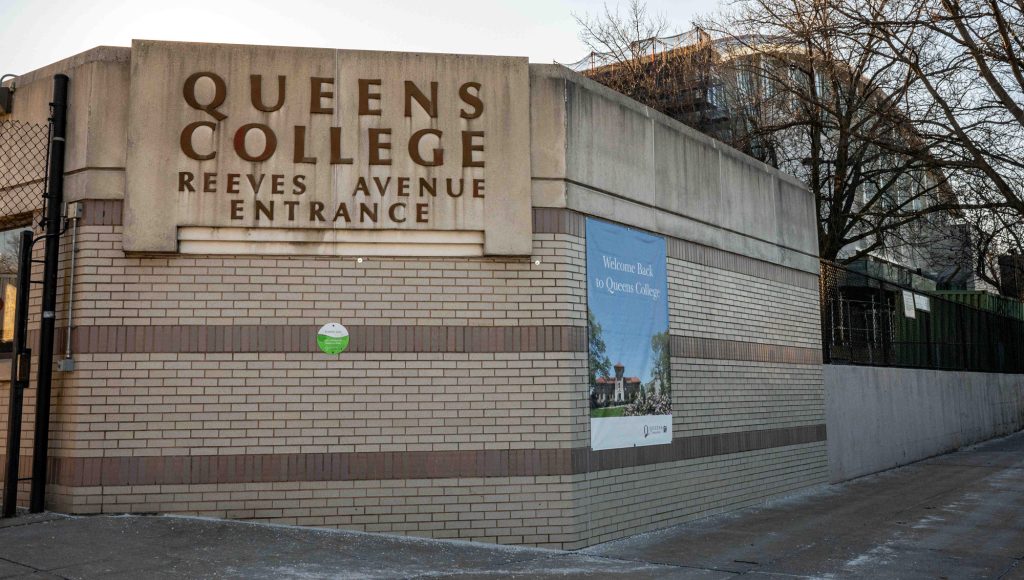On February 22, two CUNY senior colleges in Queens – Queens College and York College – received bomb threats and were evacuated. Both campuses “received the emailed threats around 12:50 p.m.,” the New York Post reported, adding, “No devices were found and the NYPD had cleared both schools by 2:30 p.m.”

Faculty and staff at Queens College are asking difficult questions. (Photo Credit: Desiree Rios)
But there was a critical difference in how the two evacuations were handled. The Post reported that Queens College switched to remote classes at 2:45 p.m., while York College went remote at 1:15 p.m. “We learned that York College received the same threat and evacuated their campus 1.5 hours before us,” Karen Weingarten, the PSC chapter chair at Queens, told her members in an email.
FINGERS POINTED
During a labor-management meeting, Queens College President Frank Wu told the PSC chapter leadership that it was CUNY’s executive vice chancellor and chief operating officer, Héctor Batista, who delayed the Flushing college’s evacuation, Weingarten said.
The PSC chapter, therefore, demanded an explanation from the CUNY central administration executive.
“We are relieved that the bomb threat turned out to be a hoax and no one was injured or killed,” Weingarten said in an email to Batista on March 25. “However, we are alarmed that you would delay the evacuation of our campus after a credible bomb threat. The dangers of teaching and working on a college campus are not theoretical, as the news reminds us regularly. This delay could have placed our lives at risk, and we are owed an explanation for what caused it.”
He responded saying, “Events such as these must be carefully assessed and coordinated with campus officials, local responder units and additional offices to support the decision-making process. Oftentimes, threat conditions and associated events change rapidly as more information becomes available. In this case, we can assure you, and the members of both campus communities, that we were consistently monitoring the situation and we were engaged in the necessary coordination with our first-responder counterparts to support informed decisions.”
INVESTIGATION
He added, “In terms of some recipients experiencing delays or not receiving CUNY Alerts at all, I have asked President Wu to investigate their system for message failures.”
For Miles Grier, an associate professor of English at Queens College, there is a disconnect between an “increasingly remote and unaccountable administration” and the rest of the campus community.
“Batista’s letter offers no concrete answers to questions that pertain to a very serious danger. The language is telling: the possessive in ‘our students, faculty and staff’ and the gulf between ‘we’ and ‘you’ in ‘we can assure you,’” he said in an email. “In the letter, ‘we’ upper administration at Central are the University. ‘You’ on the campuses belong to us and should accept assurances without concrete detail, which we’ve decided that you don’t need – even though you’ve identified them as such.”
He continued, “In my 12 years at CUNY, I’ve witnessed the increasing distance of upper administration from faculty, staff and students.” He also said, “If they want to provide assurance that would restore trust, they need to come out of their proverbial tower and bridge that distance to meet us on the sites and in the circumstances where we work.”
Natalie Vena, an assistant professor of urban studies, was unaware of any bomb threat when she walked to get a midday cup of coffee and saw students walking out of the library. She was told by one of them that there was some kind of threat and they were leaving. Then chaos ensued.
“The slow crawl to get off campus was crazy,” she said of the congestion of cars trying to leave the campus. “We were all in our cars. We were trapped – you couldn’t get off campus. I don’t think I got off campus until 3:20.”
Vena called both Wu and Batista’s explanations “just extremely confusing: Where exactly is the mismanagement?”
The clumsiness of both the response to the bomb threat and its aftermath have eroded morale at a campus where tensions are already high.
HICCUPS
“The various hiccups such as the absence of infrastructural help to evacuate, the urgency of the message, the walking back on subsequent messages, the problems with the timing – both evacuating after the campus was cleared and then the realization that the threats were treated with different levels of priority – undermine the trust that I had,” said Julie George, an associate professor of political science. “This event comes after a series of hits for QC – our budget has not been approved, we had 23 sub lines retracted just weeks before the start of the semester, with HR seemingly left in the dark about those plans. The physical conditions of the institution are degrading. HR has been making costly errors with pension and retirement deductions that will now harm employees’ bottom lines as they must pay back with interest what was not deducted. Morale was already low.”
For many faculty and staff at Queens College, the whole narrative about what exactly happened during the bomb scare remains shrouded in mystery.
“The bottom line is nobody outside of security and Batista really know what the protocol is for issuing a CUNY Alert,” said Kevin Birth, an associate professor of anthropology. “They need to get it down to at least 10 minutes.”
Birth explained that more and more students are using the Citizen app instead of waiting for CUNY Alerts to learn about possible incidents on campus. On the day of the bomb threat, Birth said, some students learned of the bomb scare via that app sooner than many others.
“I’m not sure that’s what CUNY wants,” he said.
Published: May 19, 2024

